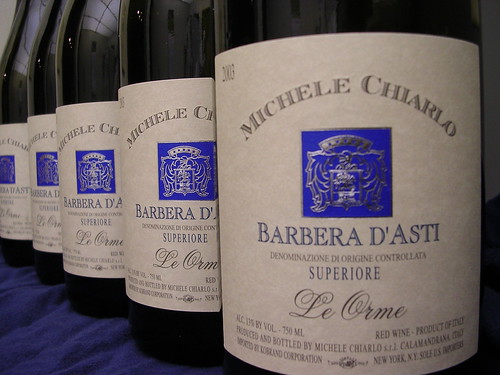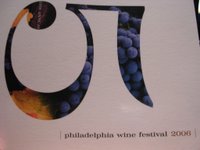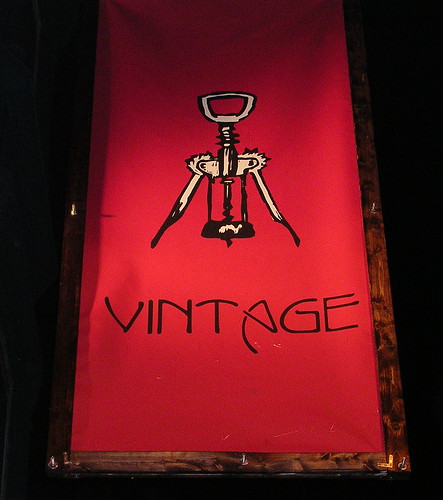 No one can dispute that the Philadelphia restaurant scene has come into its own. Yet, there are certain types of establishments that are ubiquitous in other cities but noticeably scarce in ours. The wine bar is one of them. The recent opening of Vintage Wine Bar and Bistro, however, goes a long way to filling this void.
No one can dispute that the Philadelphia restaurant scene has come into its own. Yet, there are certain types of establishments that are ubiquitous in other cities but noticeably scarce in ours. The wine bar is one of them. The recent opening of Vintage Wine Bar and Bistro, however, goes a long way to filling this void.
At Vintage, the entrepreneurial spirit is flowing almost as much as the wine. Owners Jason and Delphine Evenchik are veterans of Philadelphia’s restaurant scene who decided to open a place of their own; Jason worked at Le Bec-Fin and Delphine was the Assistant Manager of Caribou Café. In addition to having the experience, energy and street cred for this venture, the Evenchiks also had the courage to use designers they found in a nontraditional forum—craigslist. And it paid off. One of their designers, Vin Marshall of T.E. Motorworks, Inc., fabricated an eye-catching, signature chandelier: a multi-tiered wrought iron frame with collage of empty wine bottles carefully arranged upside down around the edge of each tier. It may steal your attention when you enter the room, but ultimately it reminds you of what you’re there to do—drink wine.
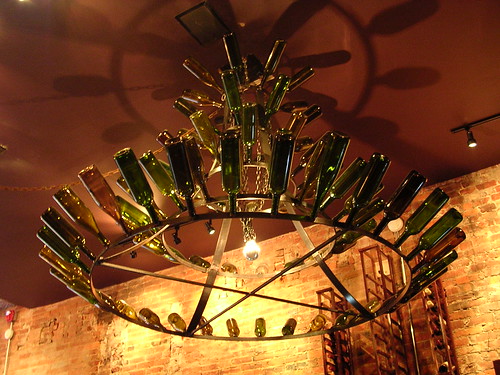
The meticulously crafted wine list is even more impressive than the chandelier. The owners have successfully managed to assemble a broad and diverse wine list without sacrificing any depth. There is something on the list for everyone and, at the same time, the wines are compelling enough to have been hand picked from someone’s private wine cellar. New wines are added frequently, guaranteeing fresh surprises on return visits. As if all of that wasn’t enough, the wines are remarkably affordable. Most glasses are between $5 and $8, and bottles, on average, run in the $30 range. Another small but incredibly valuable feature of the list is that each wine has tasting notes. Not only does this allow you to preview the wines before you drink them, it also educates you on how to identify what you’re tasting, giving you the tools you need to become your own wine critic. If you get stuck on what to choose, the wait staff is skillful at recommending something you’re bound to enjoy.
On my first visit to Vintage, this time with a friend of mine, I instinctively went for a glass of the elusive Mark West Pinot Noir 2004 ($8). The Mark West had a pleasant red fruit nose with ripe raspberry on the palate and a hint of chocolate on the finish. Our server recommended that I try a glass of the Michel Picard Cote-du-Rhone 2003 ($7), which I thoroughly enjoyed. This is a refreshing, light-bodied red, perfect for summer quaffing. The fruit in this wine is mostly on the nose, which has a soft blueberry aroma. Strong tannins grab you in the beginning, but then gently smooth out on the back and sides of your tongue for a warm, velvety finish. I enjoyed the Picard so much that I stubbornly stuck with it on my second visit to Vintage, this time with my wife. She had a glass of Ironstone Obsession Symphony 2004 ($8), which I sampled. The symphony grape is a cross between the Muscat of Alexandria and the Grenache Gris. The result is a semi-sweet white wine that has a powerful nose of peaches and tropical fruit and a light, crisp, non-oak finish.
The food menu consists mainly of small plates designed to accompany the wine. In the tradition of the authentic French bistro, daily specials are written on small chalkboards that the servers ceremoniously bring to your table. Over my two visits to Vintage, I have sampled many of their small plates (seven, to be exact), so given that I’ve already breached blogging etiquette with the length of this post, I may as well go for broke and give you all seven.
The “must have” dish on the menu has to be the Brie en Croute ($12)—baked brie wrapped in a light puff pastry served with caramelized pear and carambola (a/k/a/ star fruit). This filling, decadent delight is served with bread. The pear and star fruit are more than just garnishes. The star fruit, in particular, elevated the brie to a completely different level. Its tangy, succulent juices complemented the rich, savory brie in a unique way.
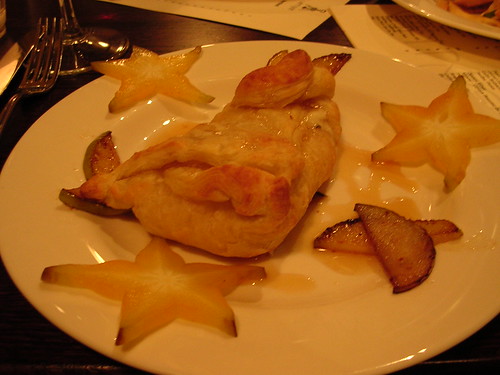
The North African Spiced Lamb kefta ($12) consists of ground lamb spiced with a variety of North African spices skewered and grilled and served with mint cilantro tzatziki. Despite its name, this dish is extremely safe. The North African spices used here are light, mild, and incredibly subtle (almost too subtle); adding, at most, a bit of sweetness to the juicy lamb. Cilantro has earned a reputation for being overwhelming at times. But that’s not the case here. The chef was careful to add just the right amount to give the cool tzatziki a light, delicate accent.
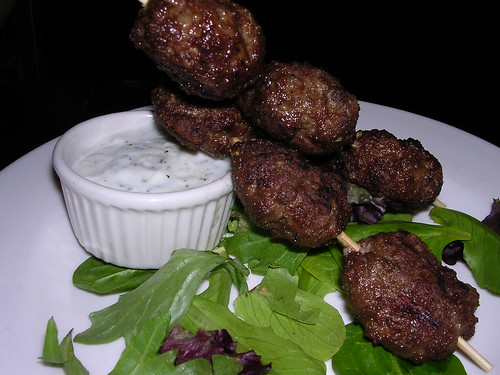
The Goat Cheese Plate ($15) was one of the daily specials. It came with three cheeses, going clockwise from one o'clock: Morbier, Capri and Cypress. The Morbier (a cow’s milk cheese that was a last minute replacement) was my favorite; sweet, creamy and deliciously nutty toward the middle and end. Coupling the Morbier with a slice of pear seemed to amplify the nutty flavor and to convince it to appear closer to the beginning. The Capri (which, if the spelling is correct, is an American goat cheese) was the least adventurous of the three, but still enjoyable; creamy with an earthy finish. The Cypress (a brand name, I believe) was earthy and tangy; pairing this with the sweet fig added some colorful balance.
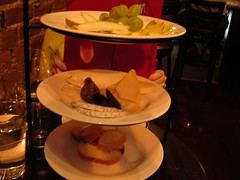
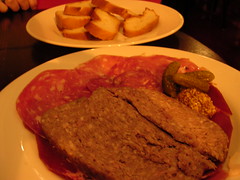
The Chacuterie Plate ($14) contains thinly sliced Parma prosciutto, soprasetta and pate de campagne garnished with Cornichon and whole grain mustard. This pate is very accessible. It is a coarsely ground traditional French country pate that is light and mild with warm garlic flavor and a short, pleasant aftertaste.
The Caesar Salad ($7.50) was light and enjoyable. The house made croutons highlight this dish. The croutons appear to have been pan fried in olive oil, making them light, crispy and addictive. The salad had only a delicate whisper of anchovy, which was curious for a Caesar but not necessarily disappointing. The manchego cheese, however, was a puzzling choice. This cheese is mild and was difficult to isolate through the creamy Caesar dressing, so it didn’t appear to add anything to the dish.
For those with a heartier appetite, there’s the Vintage Burger ($11)—a certified angus burger topped with apple wood smoked bacon, roasted red pepper and shaved manchego served with Belgian fries and a truffle smoked tomato aioli. Based on the small taste I had, the burger was respectable and satisfying, especially the sweet, smoky bacon. The truffle smoked tomato aioli, however, unexpectedly stole the show. The distinctively rich and earthy truffle oil is explosive, but not overpowering, and pairs nicely with the garlic in the tomato aioli. Although the Belgian fries and aioli should continue to be paired with the burger, they also deserve separate billing on the menu.
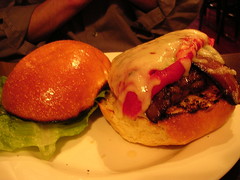
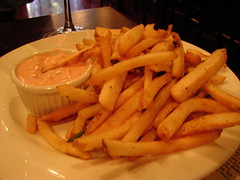
The Chocolate pot de crème ($8.00) was listed as one of the daily specials, but I’m hoping it becomes as much of a regular as I plan to be. The cream clearly is hand whipped. Beneath the cream is a sinful layer of rich, surprisingly creamy caramel. Normally, I prefer an unencumbered pot de crème, but because caramel itself was surprisingly creamy it blended seamlessly with the rich chocolate.
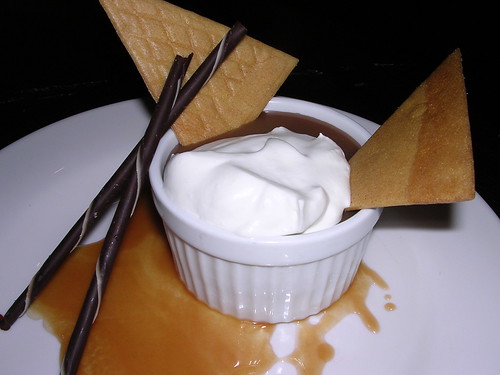
Like its wine list, Vintage’s food menu strikes a good balance. It has plates that are safe enough to give the menu a wide appeal and yet it also has enough color and authenticity to satisfy even the most discriminating foodies and keep them coming back for more.
Vintage
129 South 13th Street
(215) 922-3095
Read More....
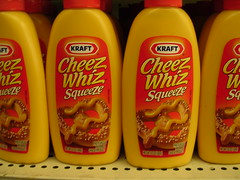 According to an article in today's Philadelphia Inquirer, the neighborhood in which Geno’s Steaks sits has become home to thousands of Mexicans. But apparently Joe Vento, the owner of Geno’s, isn’t happy. So Joe is insisting that his customers order cheese steaks in English. As the pic in the article reveals, Joe conveys this message through two signs that, naturally, are only in English: one sign has a stereotypically pissed-off looking eagle in front of an American flag and declares “This is America. When Ordering, ‘Speak English’”; the other says “Management Reserves the Right to Refuse Service.”
According to an article in today's Philadelphia Inquirer, the neighborhood in which Geno’s Steaks sits has become home to thousands of Mexicans. But apparently Joe Vento, the owner of Geno’s, isn’t happy. So Joe is insisting that his customers order cheese steaks in English. As the pic in the article reveals, Joe conveys this message through two signs that, naturally, are only in English: one sign has a stereotypically pissed-off looking eagle in front of an American flag and declares “This is America. When Ordering, ‘Speak English’”; the other says “Management Reserves the Right to Refuse Service.”